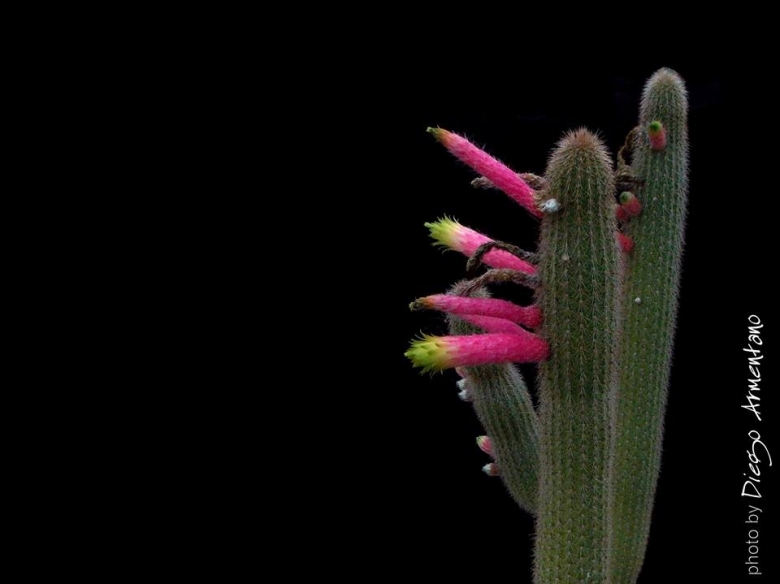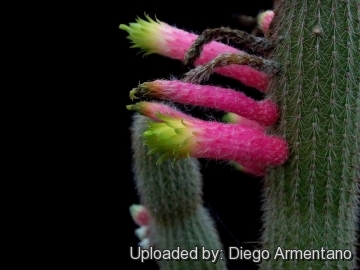Accepted Scientific Name: Cleistocactus smaragdiflorus (F.A.C.Weber) Britton & Rose
Cactaceae (Britton & Rose) 2: 174. 1920 [9 Sep 1920] Britton & Rose

Cleistocactus ferrarii Photo by: Diego Armentano
Origin and Habitat: Northern Argentina.
Synonyms:
See all synonyms of Cleistocactus smaragdiflorus
back
Accepted name in llifle Database:Cleistocactus smaragdiflorus (F.A.C.Weber) Britton & RoseCactaceae (Britton & Rose) 2: 174. 1920 [9 Sep 1920]Synonymy: 10
back
Common Names include:
ENGLISH: Fire-cracker cactus, Firecracker cactus
Description: Cleistocactus ferrari is one of the morphological or geographical form of Cleistocactus smaragdiflorusSN|7408]]SN|7408]] distinguished from the type species for its lilac-pink flowers (mostly red in smaragdiflorus) and noticeably thinner end shorter central spines, but most botanist agree on the fact that all the varieties described until now should all be included in the Cleistocactus smaragdiflorusSN|7408]]SN|7408]]. The flowers are tubular tipped with emerald green and appear most heavily in spring and summer. Cleistocactus ferrari belongs to a group of very easily flowered plants, decorative with pleasing appearance of stem and flower alike.
Stems: Cylindrical, slender, arching to creeping, 2 to 2.5(-3) cm in diameter branching basally.
Ribs: Low, 12 to 14.
Areoles: Pale brown-felted.
Radial spines: 10-14, acicular, less than 10 mm long.
Central spines: Similar to radials, yellowish to dark brown.
Flowers: Small, 4 to 5 cm long, straight, tubular, a little constricted above the pericarpels, the tube and ovary liliac. Outer perianth-segments yellow, inner perianth-segments small, bright green to emerald green, acute to mucronate not spreading. Stamens included. Style slightly exserted. Stigma-lobes 5 to 8 green.
Fruits: Globose, to 1.5 cm in diameter.
Subspecies, varieties, forms and cultivars of plants belonging to the Cleistocactus smaragdiflorus group
 Cleistocactus ferrarii R.Kiesling: has a pink flower tube (never red) and much shorter central spines.
Cleistocactus ferrarii R.Kiesling: has a pink flower tube (never red) and much shorter central spines.- Cleistocactus smaragdiflorus (F.A.C.Weber) Britton & Rose: has scarlet tubular flowers tipped with emerald green. Distribution: Bolivia and northern Argentina.
Bibliography: Major references and further lectures
1) James Cullen, Sabina G. Knees, H. Suzanne Cubey “The European Garden Flora Flowering Plants: A Manual for the Identification of Plants Cultivated in Europe, Both Out-of-Doors and Under Glass” Cambridge University Press, 11/Aug./2011
2) David Hunt, Nigel Taylor “The New Cactus Lexicon” DH Books, 2006
3) Edward F. Anderson “The Cactus Family” Timber Press, 2001
4) N. L. Britton and J. N. Rose “The 'Cactaceae', Descriptions and Illustrations of Plants of the 'Cactus' Family” volume 2 Carnegie Institution, 1920
5) Demaio, P., Lowry, M., Ortega-Baes, P., Perea, M. & Trevisson, M. 2013. Cleistocactus smaragdiflorus. The IUCN Red List of Threatened Species 2013: e.T152332A624859. . Downloaded on 26 February 2016.
6) Urs Eggli, Leonard E. Newton “Glossary of Botanical Terms with Special Reference to Succulent Plants.” British Cactus and Succulent Society, Richmond 1993
7) Haustein, “Der Kosmos-Kakteenfiihrer” 1983
8) Cullmann W., Götz E., Gröner G.”Kakteen: Kultur, Vermehrung und Pflege - Lexikon der Gattungen und Arten” Ulmer, Stuttgart, 1984
9) Navarro, G. “Catálago ecológico preliminar de las cactáceas de Bolivia.” Lazaroa 17: 33–84.1996.
10) Zuloaga, F.O., O. Morrone, M. J. Belgrano, C. Marticorena & E. Marchesi. (eds.) “Catálogo de las Plantas Vasculares del Cono Sur (Argentina, Sur de Brasil, Chile, Paraguay y Uruguay).” Monogr. Syst. Bot. Missouri Bot. Gard. 107(1): i–xcvi, 1–983; 107(2): i–xx, 985–2286; 107(3): i–xxi, 2287–3348. 2008.
 Cleistocactus ferrarii Photo by: Diego Armentano
Cleistocactus ferrarii Photo by: Diego ArmentanoSend a photo of this plant.The gallery now contains thousands of pictures, however it is possible to do even more. We are, of course, seeking photos of species not yet shown in the gallery but not only that, we are also looking for better pictures than those already present.
Read More... Cultivation and Propagation: Cleistocactus ferrari is a a much decorative hardy cactus.
Soil: Grow it in a rich and particularly draining substratum, as it is very sensitive to rottenness when in presence of humidity and low temperatures and let the soil dry out between waterings.
Water: In summer, during the vegetative period, it must be regularly watered, but allowing the substratum to completely dry up before irrigating again; in winter, it’s to be kept dry. Preferable not to water on overcast days, humid days or cold winter days.
Hardiness: This is one of hardiest of the woolly columnar cacti from Bolivia that grow at an altitude of up to 1000 meters. It is a frost resistant cactus, hardy to -7°(or even less if very dry). However in cultivation it is better not to expose it to temperatures lower than 0° C, even if in an aerated and protected location, in order to avoid the formation of anti-aesthetic spots on the epidermis. In presence of high atmospheric humidity avoid any frost as it is particularly sensitive to root rot.
Exposure: It need full sun exposures with ample airflow to produce dense hairs, but, as a former mountain dweller, does not care for extremely high temperatures in summer.
Maintenance: Repot in the spring, when their roots become cramped. Generally, they should be repotted every other year in order to provide fresh soil. After repotting, do not water for a week or more.
Use: Excellent as landscape or patio plant. It is suitable for small “desert” gardens, in association with other xerophytes. Where the open air cultivation is not possible due to the climate, it is to be cultivated in pot in order to shelter it in winter.
Propagation: By seeds and by cuttings, provided left drying up well, in summer.











